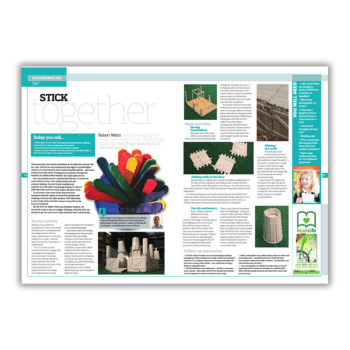Here’s a KS1 D&T challenge for the whole class… Supplied with 1000s of lolly sticks, can they design and construct their own castle?
This lesson plan started life somewhere in the Alps one summer. My six-year-old son Joe was entranced by the sight of a model alpine chalet in a local restaurant. It was full of entrancing little details, and made entirely from lolly sticks.
Pointing at the structure through the window, he politely asked whether we could make one too. Ever the positive parent, I assured him that yes, of course we could.
Which is why, a few weeks further into the summer holidays, Joe and I found ourselves sat together at an old table in the garage looking at a box of 1000 lolly sticks and two tubes of glue. We got to work.
To be honest, there were times when we both wondered whether taking on board this architectural challenge had been the right decision. 1000 lolly sticks is a lot of lolly sticks and there weren’t many left by the time we’d finished.
But once we finished our alpine chalet, we were both ready to take on a bigger challenge. Only this time, we decided to get the rest of Joe’s KS1 D&T class involved. Here’s what we did…
KS1 D&T starter activity
The perfect prep for this KS1 D&T projects would be visiting a real castle and learning about its construction. For one thing, castles took our ancestors a long time to build – and the key to success for this project is collaboration.
First, try to ensure that everyone involved is happy with the design for the planned structure. Begin the design process by asking children to make sketches that could inform the basic structure of the castle. Discuss the requirements for the design, encouraging them to think about essentials such as towers, turrets and drawbridges.
Next, talk about the different designs that emerge from this process. It may be that one design emerges as the class favourite. Or, you can combine certain elements from several designs to great effect. Warn children that, although it’s a good idea to try and stick to the design, they’ll need to be flexible as they build.
Depending on your KS1 D&T pupils’ age and level of independence, you can assign different tasks to different groups.
Robert Watts is the course leader for the PGCE Secondary Art and Design programme at the University of Roehampton, London, and the co-editor of Teaching Art and Design 3-11, published by Continuum Books.














